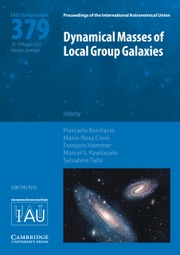No CrossRef data available.
Article contents
Dense molecular clouds and associated star formation in the Magellanic Clouds
Published online by Cambridge University Press: 01 August 2006
Abstract
Multiwavelengths studies of massive star formation regions in the LMC and SMC reveal that a second generation of stars is being formed in dense molecular clouds located in the surroundings of the massive clusters. These dense molecular clouds have survived the action of massive star UV radiation fields and winds and they appear as compact dense H2 knots in regions of weak CO emission. Alternatively, we have found that large molecular clouds, probably remnants of the parental giant molecular clouds where the first generation of stars were formed, are suffering the interaction of the winds and UV radiation field in their surfaces in the direction of the central massive cluster or massive stars. These molecular regions show 1.2 mm continuum emission form cold dust and they show embedded IR sources as determined from deep ground base JHKs imaging. The distribution of young IR sources as determined from their Mid IR colors obtained by SPITZER concentrate in the maxima of CO and dust emission. IR spectroscopy of the embedded sources with high IR excess confirm their nature as massive young stellar objects (MYSO's). Our results are suggestive of contagious star formation where triggering and induced star formation could be taking place.
- Type
- Contributed Papers
- Information
- Proceedings of the International Astronomical Union , Volume 2 , Symposium S237: Triggered Star Formation in a Turbulent ISM , August 2006 , pp. 40 - 46
- Copyright
- Copyright © International Astronomical Union 2007


